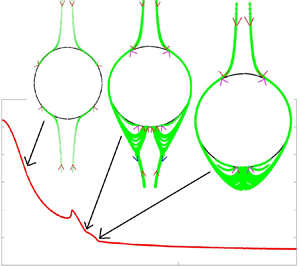Article contents
Collision rate of bidisperse spheres settling in a compressional non-continuum gas flow
Published online by Cambridge University Press: 08 January 2021
Abstract

Collisions in a dilute polydisperse suspension of spheres of negligible inertia interacting through non-continuum hydrodynamics and settling in a slow uniaxial compressional flow are studied. The ideal collision rate is evaluated as a function of the relative strength of gravity and uniaxial compressional flow and it deviates significantly from a linear superposition of these driving terms. This non-trivial behaviour is exacerbated by interparticle interactions based on uniformly valid non-continuum hydrodynamics, that capture non-continuum lubrication at small separations and full continuum hydrodynamic interactions at larger separations, retarding collisions driven purely by sedimentation significantly more than those driven purely by the linear flow. While the ideal collision rate is weakly dependent on the orientation of gravity with the axis of compression, the rate including hydrodynamic interactions varies by more than  $100\,\%$ with orientation. This dramatic shift can be attributed to complex trajectories driven by interparticle interactions that prevent particle pairs from colliding or enable a circuitous path to collision. These and other important features of the collision process are studied in detail using trajectory analysis at near unity and significantly smaller than unity size ratios of the interacting spheres. For each case analysis is carried for a large range of relative strengths and orientations of gravity to the uniaxial compressional flow, and Knudsen numbers (ratio of mean free path of the media to mean radius).
$100\,\%$ with orientation. This dramatic shift can be attributed to complex trajectories driven by interparticle interactions that prevent particle pairs from colliding or enable a circuitous path to collision. These and other important features of the collision process are studied in detail using trajectory analysis at near unity and significantly smaller than unity size ratios of the interacting spheres. For each case analysis is carried for a large range of relative strengths and orientations of gravity to the uniaxial compressional flow, and Knudsen numbers (ratio of mean free path of the media to mean radius).
Information
- Type
- JFM Papers
- Information
- Copyright
- © The Author(s), 2021. Published by Cambridge University Press
References
REFERENCES
- 12
- Cited by


